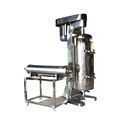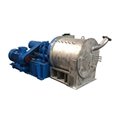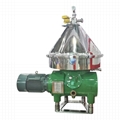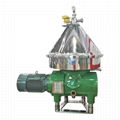| Model: | LWS |
|---|---|
| Brand: | LYSZ |
| Origin: | Made In China |
| Category: | Industrial Supplies / Machinery / Separation Equipment |
| Label: | - |
| Price: |
US $18500
/ pc
|
| Min. Order: | 1 pc |
| Last Online:06 Jun, 2022 |
HOW DOES IT WORK
The feed product is pumped into the decanter centrifuge through an inlet. Feed into a horizontal bowl and then rotate. The bowl consists of a cylindrical portion and a conical portion. The separation takes place in the cylindrical part of the bowl. Fast rotation produces centrifugal forces of up to 4000 x g. Under these forces, solid particles with a higher density are collected and compacted on the wall of the bowl. The scroll (also a screw conveyor or screw conveyor) rotates inside the bowl at slightly different speeds. This speed difference is called a differential speed. In this way, the scroll conveys the precipitated particles along the cylindrical portion of the bowl to the conical end of the bowl. At the smallest end of the conical portion of the filter bowl, dehydrated solids leave the filter bowl through the discharge port. The clarified liquid exits through the mating disc (internal centrifugal pump).
With a 3 phase decanter centrifuge, it is possible to separate 3 phases from each other in one process step only. For example, two liquids which cannot be mixed because of different densities (e.g. oil and water) are separated from a solids phase. The heavy liquid (water) collects in the middle between the oil and the solids layer. Thus the two liquids separated from each other can be drawn off from the decanter. The solids are transported via the scroll to the discharge openings as it happens also in 2-phase separation.
Typical applications of 3-phase separation are the production of edible oils such as olive oil, oil sludge processing, the production of biodiesel .











